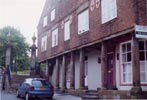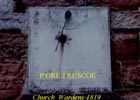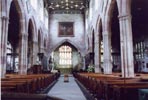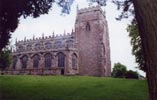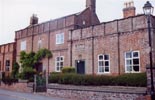Photos
Malpas, Cheshire – June 2001
Malpas, Cheshire – an introduction
Malpas and its name
From its strategic position on a spur of the Broxton hills, Malpas has played a dominant role in the history of south-west Cheshire. The Romans had some sort of station here, and when the Norman, Hugh Lupus, was granted the Earldom of Chester by William the Conqueror, the Barony of Malpas was given to his bastard son Fitz Hugh. He was one of the eight barons who formed the Earl's parliament or court, and the fact that he held the premier position reminds us of the importance of Malpas in those days.
This importance came from two separate things. Firstly, from the richness of the land and therefore the wealth of those who held it and, secondly, from its strategic position with regard to the Welsh. Perched on its hill with a view of forty miles into Wales, Malpas was well placed to play a major role in curbing the constant raids on the rich farms of south Cheshire. It was part of a defence system which included the castles at Shocklach and Oldcastle. These castles, all dating from about 1100, were earth mounds surrounded by ditches fortified with timber stakes, and topped by timber towers from which the archers could command a wide area. The mound just to the north of the church is all that remains of Malpas Castle. The name of the town gives some indication of the difficulties of travel and movement; the ancient name of “Depenbech” meaning “deep brook,” and the Norman name of Malpas meaning “bad road.”
The nearness of Malpas to Wales must have been uncomfortable and inconvenient for its inhabitants as is demonstrated by an appeal made about 1300 for permission to have the rites of baptism and burial performed in Cholmondeley Chapel. The reason being “that the dead in time of war are buried in the fields, because the church of Malpas is so near to Wales that part of the parish belongs to the Welsh and part to the English. Wherefore the English dare not go with their dead to the said church of Malpas in time of war. And likewise at one time it happened that no English-man dared to come to the said parish church on Easter Day to receive the Body of Christ for fear of the Welsh.” The appeal was, however, dismissed.
The Dual Rectory
From very early times there were two rectors of Malpas and various suggestions, some exceedingly picturesque, have been put forward to explain this fact. However, it would seem that there are only two worthy of serious consideration. The Revnd. J. E. Newell, in his “History of the Welsh Church” (1895), makes this suggestion: “The curious succession system practiced in Wales whereby benefices descended from father to son, led in some cases to a strange abuse, the custom of dividing benefices between various incumbents. The church of Kerry, Montgomery, had two rectors; Hey in Radnor was divided between two brothers…” As part of the ancient parish of Malpas was actually in Wales, this custom may have crept over the border. If this is the truth, then the division happened at a very early date for there were two rectors in 1285, namely William of Audlem of the Higher Moiety and Leodegarius of Nottingham of the Lower Moiety. Another explanation, and perhaps the more probable one, is that when Fitz Hugh died leaving no heir, the barony was divided between his two daughters, Letitia and Mabilia. It may well be that at the same time the rectory was divided into two moieties. The dual rectory continued right down to 1885 when it was abolished and the ancient parish of Malpas broken up to form the new parishes of Whitewell, Bickerton, Bickley and Tushingham.
The Church of Saint Oswald
The church is dedicated to Oswald, King of Northumbria and Martyr, who was killed in battle against Penda, the heathen King of Mercia, on 5th August, 642, at Maserfield (perhaps the modern Oswestry).
It is tantalising that where such an architectural gem as Malpas Church is concerned, we are in almost complete ignorance as to its origin. We do not know who organised the building of it, or who were the benefactors, or the architect, or the builders. We do not even know its date with any accuracy.
The present church was built in the second half of the 14th century on the site of an earlier church. There are no structural remains of this earlier church surviving; no 12th or 13th century masonry has come to light, and practically the only evidence we have is contained in the list of rectors. The earliest record is of an agreement between the rectors and Hugh of Cholmondeley, dated 12th November, 1285, granting him the right to have a fit chaplain to celebrate Divine Service in his chapel of Cholmondeley under certain conditions.
The plan of the present church is formed by a nave of six bays having wide aisles with eastern chapels, and a three-bay chancel beneath which is a vaulted treasury and, to the west, a massive tower. The measurements of the building are as follows: total length 145 feet, total width 71 feet; not including the buttressing. The tower is 25 feet square and just over 70 feet high, the nave and aisles are 81 feet in length and the chancel 33 feet.
This extract is taken from An Illustrated History of St Oswald's Malpas, by the then rector, Rev Canon T M Rylands, MA (undated). A Moiety, incidentally is simple a legal term meaning one of two divisions, or a half.
As may be seen, the church is unusually large for a small town – or large village. The chapel in the north aisle has monuments to the Cholmondeley family, and in the south to the Brereton's. Also at least one member of the Egerton family is buried here – all three being important Cheshire families. There are finely decorated ceilings, as well as tombs, screens, box pews and misericords.
For more information try Vision of England (full of historical information) and Pictures of England (only a couple at present, but we could add some) or the Francis Frith website (which has more than postcards but hopes to sell you something).

